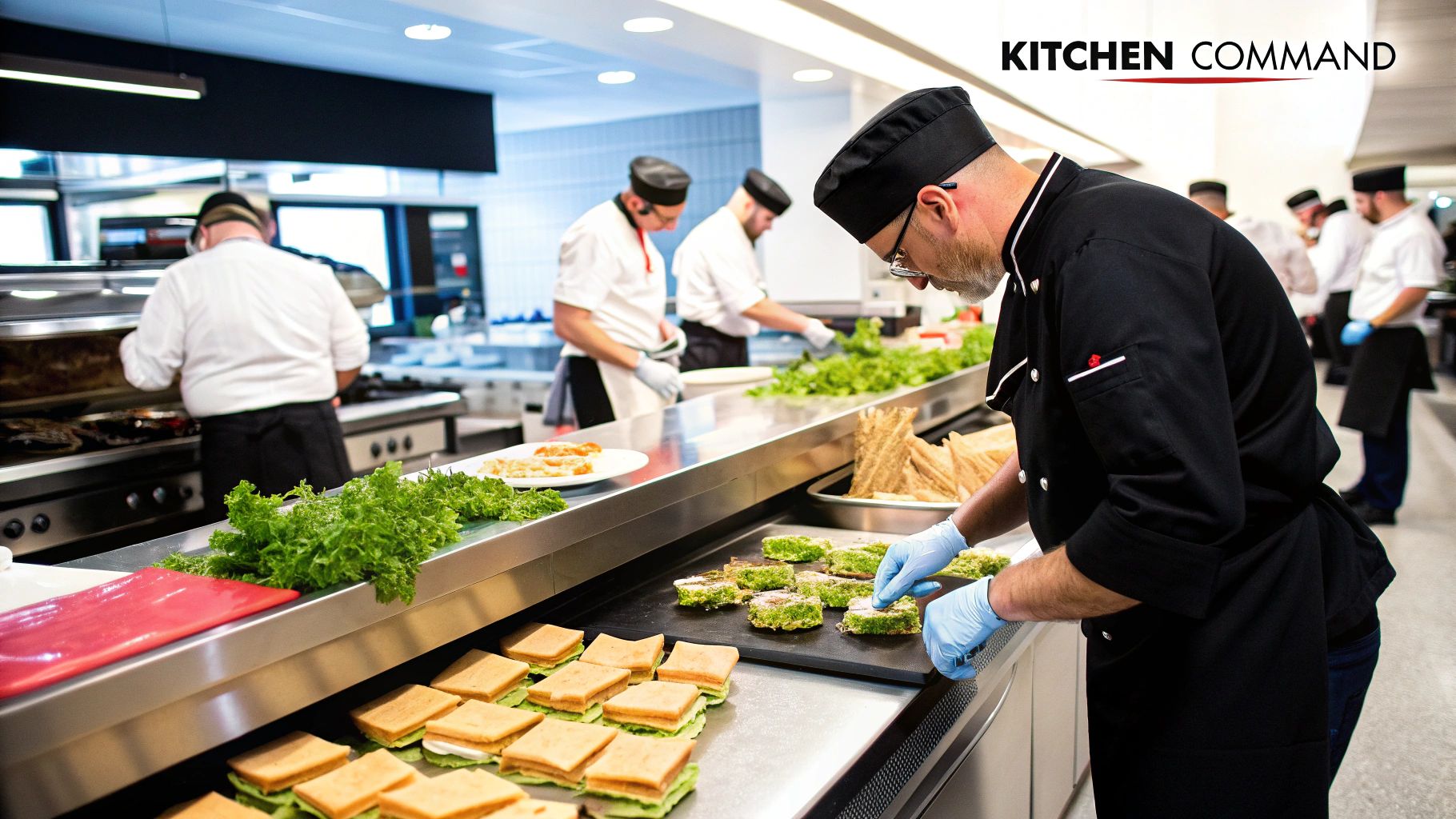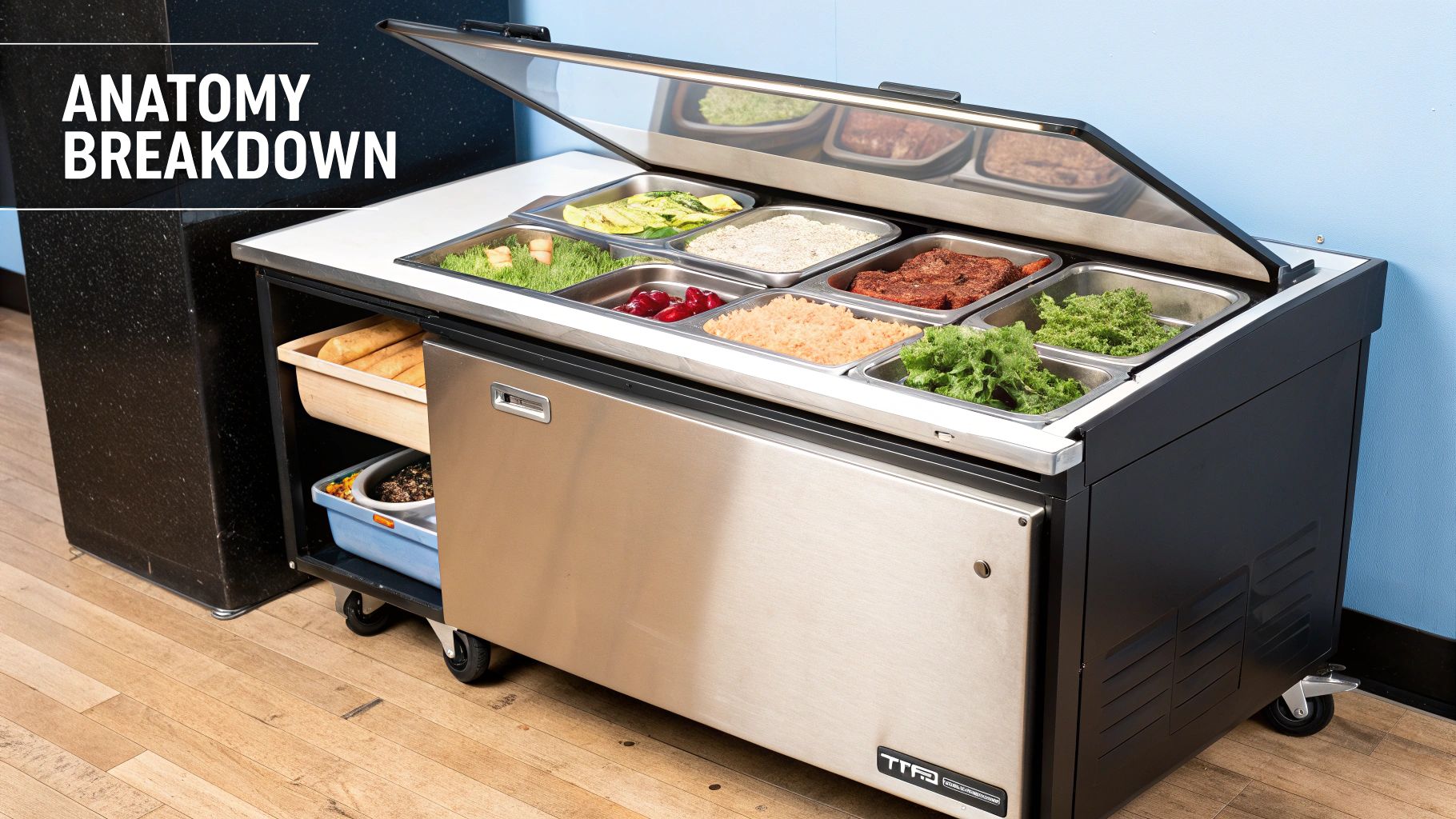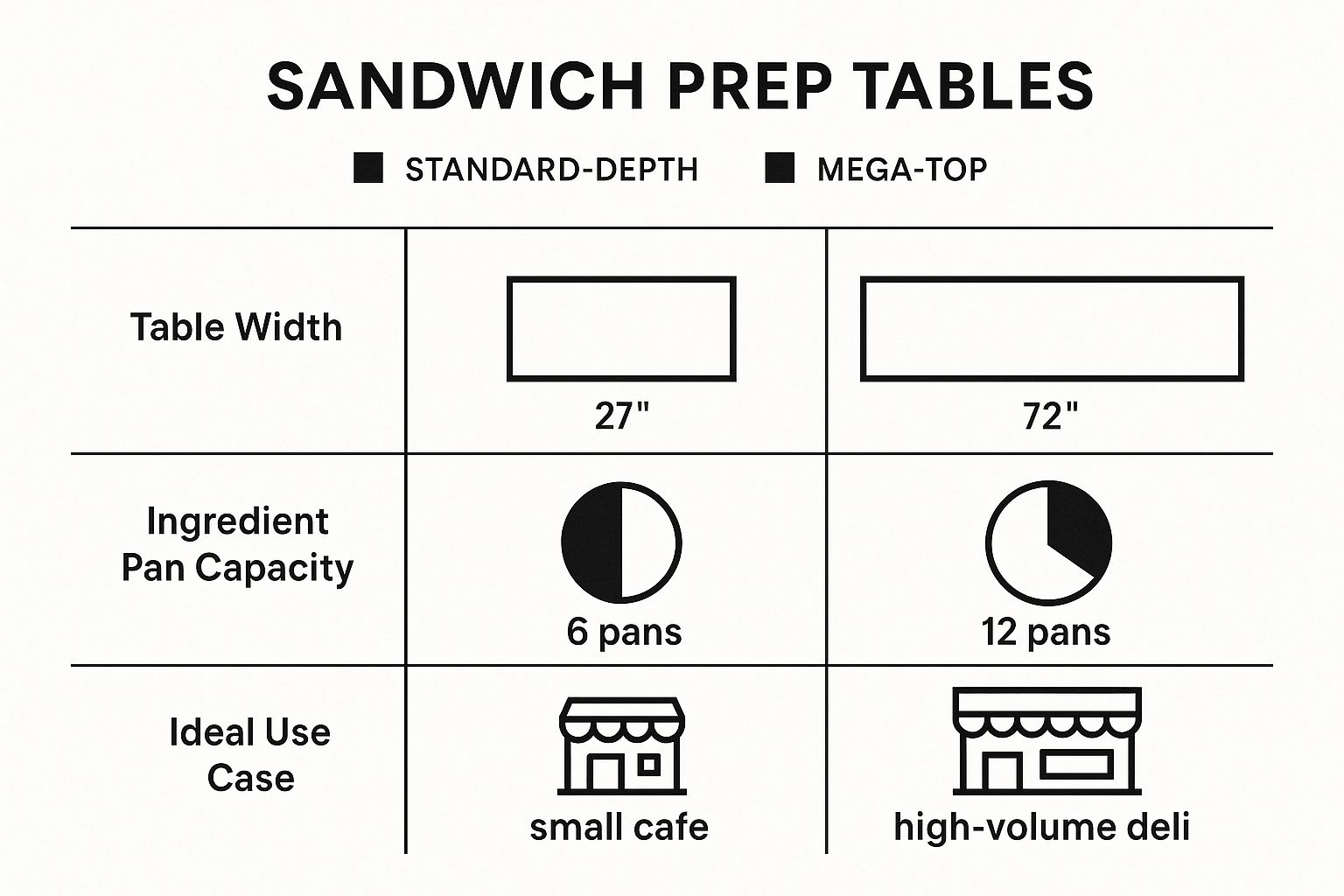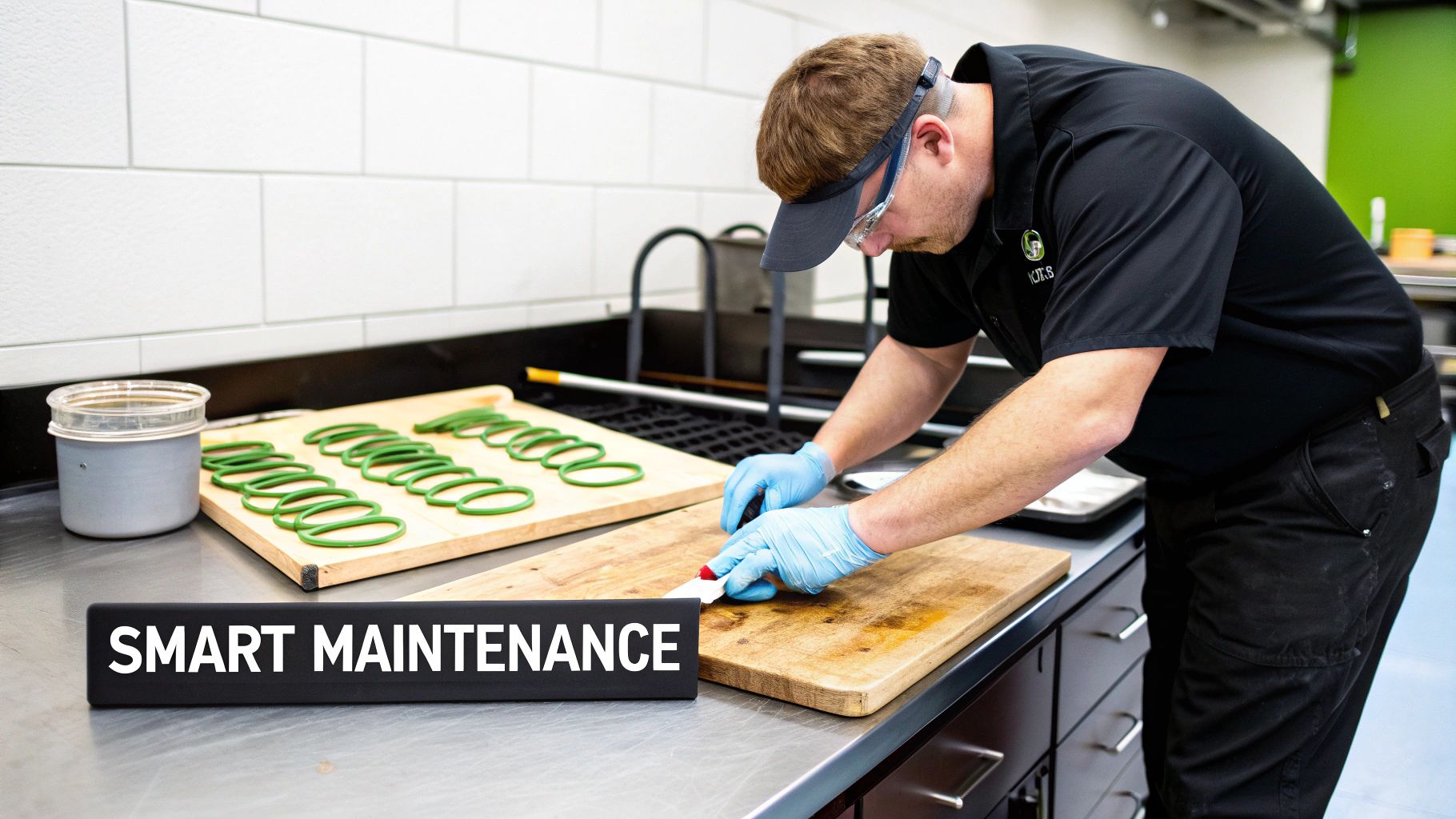
Your Essential Guide to Commercial Griddles
In any kitchen that needs to pump out food at high volume, the commercial griddle is the undisputed MVP. It's your go-to for everything from morning pancakes to those evening smash burgers, delivering consistent, powerful heat every single time. Think of it less like just a hot surface and more like the central engine driving your kitchen’s entire production line.
The Secret Weapon Of A Productive Kitchen

Picture the peak of the lunch rush. Tickets are flying, and the only thing standing between you and chaos is pure efficiency. This is where a high-performance commercial griddle truly shines, becoming the command center for your entire operation. It’s the assembly line where you get speed, consistency, and that perfect sear all in one place.
A good griddle can turn a disjointed, pan-juggling cooking process into a smooth, organized workflow. Instead of messing with multiple pans on a range, you get one huge flat-top surface, often with different heat zones. This lets a chef sear burgers on a high-heat section while gently toasting buns on a cooler spot just inches away.
Slashing Preparation Times
The most immediate benefit you'll see is how drastically it cuts down cook times. That massive surface area is built for cooking in large batches. A 36-inch or 48-inch griddle can handle dozens of burger patties or pancakes at once—something that would normally take up an entire bank of ranges and a small army of pans to even attempt.
This directly translates to lower labor costs. Suddenly, one cook can manage the output that used to require two or three line cooks fumbling with traditional pans. That's a huge deal for keeping ticket times down and ensuring a smooth service during your busiest hours.
Boosting Consistency And Food Safety
Speed is great, but a griddle also gives you incredible control over the final product. Thermostatic controls keep the temperature precise across the cooking plate, making sure every single pancake, egg, or patty is cooked perfectly, every time. That's the kind of consistency that defines a professional kitchen and is nearly impossible to nail with standard stovetop cooking.
On top of that, the smooth, non-porous surface is a breeze to clean and sanitize, which is a massive win for food safety. Quick scrapes between orders prevent flavors from mixing and cut down the risk of cross-contamination, keeping your cooking station clean and professional.
It's no surprise that the market for reliable kitchen equipment is growing. The broader food prep tables industry, which includes these kinds of workstations, was valued at around USD 1.18 billion in 2023 and is expected to hit USD 1.62 billion by 2029. You can discover more insights on the food prep table market growth on Arizton.com.
A commercial griddle isn’t just about cooking more food; it's about cooking better food, faster. It centralizes your production, reduces unnecessary movement, and gives chefs the consistent heat they need to execute a menu flawlessly, service after service.
At the end of the day, this single piece of equipment becomes the heart of your production line. Whether you're running a deli, a diner, a high-end restaurant, or a ghost kitchen, the commercial griddle is an essential piece of gear that pays for itself in speed, consistency, and lower operating costs.
Decoding the Anatomy of a Commercial Griddle

To really get why a commercial griddle is such a workhorse, you've got to look under the hood. It’s way more than just a hot slab of metal. Every single part is engineered to work in harmony, giving you that consistent heat and rock-solid performance you need to survive a chaotic dinner rush.
Once you understand the anatomy, you can look past the price tag and see what actually makes a griddle great.
Think of it like a high-performance engine. The griddle plate is where the rubber meets the road—or in this case, where the burger meets the heat. This is your cooking surface, usually made from tough polished steel or cast iron, built to soak up heat and spread it evenly.
The thickness of this plate, often between 3/4-inch to a full 1-inch, acts like a thermal battery. It stores a massive amount of heat so the surface temperature doesn't plummet the second you slap down a dozen cold burger patties.
Underneath that plate, you'll find the heart of the machine: the heating elements. On gas models, it's a series of powerful burners. For electric griddles, it's rugged heating elements tucked right under the plate. The quality of these parts directly affects how fast the griddle heats up and, more importantly, how quickly it recovers. That recovery speed is everything for keeping up the pace, ticket after ticket.
The Griddle Plate: Your Cooking Canvas
The griddle plate is your command center, so its design is make-or-break for your daily workflow. Most are stainless steel because it can take a beating from constant scraping and cleaning day in and day out.
A crucial feature you'll notice is the splash guard—those raised edges along the back and sides. They serve a simple but vital purpose: keeping grease from splattering everywhere. This keeps your line cleaner, your floors safer, and prevents cross-contamination between workstations. It's a small detail that makes a huge difference in kitchen hygiene.
Up front, there's the grease trough, a channel designed to catch all the rendered fat and oil. This trough funnels all that mess away from your food and into a removable drip tray. A well-designed system makes cleanup a breeze, letting cooks quickly scrape down between orders and do a thorough clean at closing.
The design of the griddle plate, from its thickness to its grease management system, is a direct reflection of its intended use. A thicker plate offers superior heat retention for high-volume searing, while an efficient drip tray streamlines sanitation, saving valuable time and labor.
Controls And Construction
It's not just about the cooking surface. The knobs you turn and the frame holding it all together determine how easy the griddle is to use and how long it will last. You need pinpoint control over the heat, which is why most modern units come with thermostatic controls. These let you set exact temperatures, creating different heat zones for cooking delicate eggs on one side while getting a hard sear on steaks on the other.
As for the body, you'll almost always see stainless steel on a quality commercial griddle. It's the industry standard for good reason:
- Durability: It stands up to rust, corrosion, and the general abuse of a busy kitchen.
- Sanitation: The surface is non-porous, making it simple to clean and sanitize to meet health codes.
- Longevity: A solid stainless steel frame means the griddle will be a reliable part of your line for years.
Finally, don't overlook the adjustable legs. It seems minor, but being able to level the unit on an uneven floor and match its height to the rest of your cook line is a huge practical advantage. Every piece, from the knobs down to the feet, is there to make your job faster, easier, and more efficient.
Finding the Perfect Commercial Griddle for Your Menu
Choosing the right commercial griddle isn’t just about grabbing the biggest one you can find. It’s about matching the gear to your kitchen’s real-world flow. Get it right, and that griddle becomes a force multiplier, making your team faster and more consistent. This guide will walk you through picking the right size, style, and features for your business.
We’ll look at the workhorse standard flat-tops versus the more specialized units built for places pumping out tons of ingredient-heavy dishes. You’ll see how a tight 27-inch countertop model can be a lifesaver in a small cafe, while a beastly 72-inch griddle can anchor the line in a slammed diner. The goal here is to find a piece of equipment that boosts your productivity, not just fills a spot on the line.
Sizing Your Griddle for Success
The first and most important decision is size. A griddle that’s too small will create a bottleneck during the rush. One that’s too big just wastes energy and precious hood space. Think of it like a pot for soup—too small and it boils over, too big and you're just heating air.
Let your menu be your guide. Figure out your peak demand. How many burgers, pancakes, or steaks are you firing at once during your busiest hour? A solid rule of thumb is to give each cook about 12 inches of griddle width to work with.
For instance, a small breakfast spot could get by perfectly with a 24-inch model for eggs and bacon. A busy food truck, however, might need a 36-inch or 48-inch surface to keep orders flying out the window. And those high-volume steakhouses or classic diners? They’re often running 60-inch or even 72-inch monsters that can handle dozens of tickets without missing a beat.
Gas vs. Electric and Other Key Features
Most commercial griddles come in two main types: gas and electric. Gas griddles heat up and recover temperature extremely quickly, making them ideal for high-volume kitchens that need rapid response. Electric models offer more precise temperature control, perfect for delicate items like eggs or for kitchens without a gas hookup.
But some kitchens have very specific needs. A burger joint famous for its loaded creations might need a setup that works more like an assembly line. While the griddle itself doesn't hold cold toppings, its position next to a prep station is everything. A high-volume kitchen might pair a large griddle with specialized equipment, like the units in our pizza prep tables collection, to create an unstoppable production machine.
A standard griddle gives you the freedom to cook almost anything. A specialized griddle setup, on the other hand, is all about optimizing for a high-volume, focused menu where shaving seconds off each order means more money in the bank.
The infographic below shows how different griddle sizes are built for different scales of operation—it’s all about matching the tool to the job.

This visual makes it pretty clear: matching the equipment's capacity to your business's volume is the key to a smart purchase.
Real-World Scenarios: Choosing Your Griddle
Let's see what this looks like in a couple of real kitchens.
-
The Small Cafe: A cozy spot with a tiny kitchen needs to be smart with every inch. A 27-inch countertop electric griddle is a perfect fit. It's ideal for grilled cheese, eggs, and warming pastries without needing a huge hood or a gas hookup. It makes the most of their limited space while giving them the consistent heat they need.
-
The High-Volume Deli: A deli slinging hundreds of hot sandwiches during the lunch rush needs serious firepower and real estate. A 48-inch or 60-inch gas griddle with thermostatic controls is non-negotiable. This lets them set up different heat zones—one screaming hot for searing meats, another at a lower temp for toasting buns, and maybe a third for holding. This setup is the engine that drives their whole line.
At the end of the day, the right griddle should feel like a natural part of your kitchen's rhythm. It should make your cooks' lives easier, not harder. By taking a hard look at your menu, space, and volume, you can pick a unit that will be a reliable, profit-driving workhorse for years to come.
Protecting Your Investment with Smart Maintenance

Your commercial griddle is the engine of your kitchen. And just like any high-performance engine, it needs regular care to keep it firing on all cylinders. Smart maintenance isn't just about wiping it down; it's a game plan to protect your investment, extend its life, and guarantee top performance, shift after shift.
Think of it this way: a few simple habits can stop expensive emergency repair calls in their tracks and keep your griddle turning out perfectly cooked food. This approach turns a chore into a profit-saving strategy. Following a simple schedule for daily, weekly, and monthly tasks helps you dodge the kind of downtime that can sink a busy service.
Your Daily Griddle Care Routine
The bedrock of good griddle maintenance is a solid daily cleaning routine. This isn't just for show—it prevents flavors from bleeding between different foods and stops that nasty carbon buildup before it gets a foothold. It's like hitting the reset button at the end of every day.
When service is over, while the griddle is still warm, grab a griddle scraper and get all the leftover food bits and grease off the surface. It's way easier to do this while it's warm than after everything has cooled and hardened into cement. Next, hit it with a food-safe griddle cleaner, scrub with a griddle brick or pad, and wipe it all down with a damp cloth.
The final, and most important, step is seasoning. Once the surface is clean and totally dry, wipe on a thin layer of cooking oil. Heat the griddle until the oil just starts to smoke. This simple step creates a protective, non-stick layer that prevents rust and makes the next day's cook run that much smoother. It’s a five-minute job that can add years to your griddle's life.
Weekly and Monthly Maintenance Checks
Daily cleaning takes care of the cooking surface, but you need to look a little deeper to keep the whole machine running right. These quick weekly and monthly checks focus on the parts that make the griddle work, ensuring it’s running safely and efficiently. Spotting a small issue early can save you from a major breakdown later.
Weekly Tasks:
- Inspect the Grease Trap: Empty and clean out the grease trap or drip tray. A full trap is a serious fire hazard and can cause a greasy, unsanitary mess.
- Check Gas Connections: For gas models, give the hoses and connections a quick look-over for any signs of cracks, wear, or leaks.
- Calibrate Thermostats: If you’re noticing hot spots or uneven cooking, check the thermostat's accuracy with an infrared thermometer and adjust it if needed.
A well-maintained griddle is an energy-efficient griddle. Simple tasks like keeping components clean ensure the unit heats up faster and holds temperature more effectively, directly translating to lower energy consumption and reduced utility costs over time.
For kitchens that need to pair their hot line with efficient cooling, an undercounter refrigerator can create a powerful and compact workstation. Keeping all your equipment in top shape just makes for a more reliable kitchen.
The Critical Monthly Task: Cleaning Burners and Air Shutters
The single most important monthly job, especially for gas griddles, is cleaning the burners and air shutters. Clogged burner ports from grease and food debris cause uneven flames, creating hot and cold spots across your griddle plate.
To clean them, just remove the burners and use a wire brush to clear out any gunk from the ports. Make sure the air shutters, which mix air and gas, are also free of grease. A clean burner will have a steady, blue flame—the sign of perfect efficiency. This one task will keep your commercial griddle performing like it’s brand new.
Making a Smart Purchase Beyond the Price Tag
When you're ready to pull the trigger on a new commercial griddle, the sticker price is just the starting point. The real difference between a decent purchase and a fantastic one—an investment that pays you back for years in reliability and lower operating costs—comes down to the details. We're talking about looking past the initial cost to understand critical certifications, what the warranty actually covers, and where the industry is heading.
A smart buy is a piece of equipment that not only crushes it on day one but also protects your business down the road.
Navigating Certifications and Warranties
First things first: always, always look for the NSF certification. That little mark isn't just a suggestion; it's proof that the griddle meets strict public health standards for safety and sanitation. Health inspectors will be looking for it, making this a non-negotiable for any commercial kitchen.
Next, you have to get into the weeds of the warranty. A solid warranty is the manufacturer's way of saying, "We stand by this thing." Don't just glance at the length; understand what it covers. It's usually broken down into a few key areas:
- Parts: This covers the physical components—think knobs, burners, or thermostats—if they fail because of a defect.
- Labor: This is a big one. It covers the cost of sending a certified technician out to do the repair. A warranty without labor coverage can leave you on the hook for some seriously expensive service calls.
- Specialized Components: For some equipment, major parts like compressors get a separate, longer warranty. On a griddle, you need to know exactly how the griddle plate and heating elements are covered, as they do the heavy lifting.
Knowing these specifics helps you see the potential long-term costs and choose a brand that truly has your back.
The Long-Term Payoff of Energy Efficiency
Sure, an energy-efficient griddle might cost a bit more upfront, but it's an investment that pays you back month after month on your utility bills. Models built with high-efficiency burners or better heat retention simply use less gas or electricity to stay hot. Over the five- to ten-year life of a commercial griddle, those savings can easily add up to more than the initial price difference.
Investing in an energy-efficient model is a direct investment in your profitability. Lower utility bills mean a healthier bottom line, turning a simple equipment purchase into a strategic financial decision.
Take, for example, a griddle with a thick, polished steel plate. It holds heat incredibly well, meaning the burners don't have to kick on as often to keep the surface temperature steady during a chaotic rush. This not only cuts down on energy use but also gives you a more consistent cooking surface. Our own SSTW-3048 griddle model is a perfect example, designed with exactly these performance principles in mind.
Staying Ahead with Industry Trends
Finally, a truly smart purchase looks toward the future. The world of commercial kitchen equipment is always changing, with a huge push right now towards sustainability and smarter tech. The market for related equipment, like prep tables, is expected to hit around USD 1.8 billion by 2033, largely because customers are demanding more sustainable practices. In fact, 50% of consumers now say sustainability is a factor in their dining choices. You can learn more about these foodservice equipment trends from Verified Market Reports.
Keep an eye on two big trends: eco-friendly components and smart controls. Manufacturers are moving toward greener materials and production processes. At the high end, some griddles now feature smart temperature monitoring and digital controls that offer incredible precision, helping you cut down on food waste and nail your consistency every single time. Choosing a griddle that lines up with these trends ensures your kitchen stays modern, compliant, and efficient for years to come.
Your Top Commercial Griddle Questions, Answered
Jumping into a big purchase like a commercial griddle always brings up some practical questions. Getting the right answers is key—it’s the difference between just buying a piece of equipment and truly mastering it for the long haul. Let's tackle the most common questions about choosing, using, and maintaining your griddle to keep it running smoothly and stop small issues from turning into major headaches.
When you're staring at different flat-top cookers, it can feel a bit confusing. But it all comes down to how the design works with your menu and your kitchen's rhythm.
What Is the Real Difference Between a Standard Griddle and a Plancha?
Sure, a standard commercial griddle and a plancha might look like twins at first glance, but they cook in completely different ways. A standard griddle has burners or heating elements running underneath the entire plate. The whole point is to create one big, consistent, even cooking zone. It's the undisputed champ for churning out huge batches of pancakes, bacon, or burgers where every item needs the same amount of heat.
A plancha, on the other hand, is all about creating heat zones. It usually has a super-hot heat source right in the middle, which then fades out toward the edges. This setup is a chef's playground. You can get a hard sear on a piece of fish in the center while gently warming some asparagus on the cooler outer ring, all at the same time.
Think of it this way: a griddle is for controlled, consistent batch cooking. A plancha is a dynamic, multi-tasking surface for cooking on the fly.
Nailing this difference is the first step to making sure you get the right tool for your kitchen's style.
How Often Should I Really Clean the Burners?
For any gas griddle, giving the burners and air shutters a good cleaning is a non-negotiable monthly task. But treat that as your starting point, not a hard rule. If your kitchen is a grease-fest with fryers and charbroilers going full tilt, that airborne grease will clog up your burner ports in no time. For high-grease spots, you should be checking and cleaning them every two weeks.
Clogged ports are bad news. They starve the burner of oxygen, creating a weak, flickering yellow flame instead of a powerful, steady blue one. This leads to frustrating hot and cold spots across your griddle. A quick scrub with a wire brush keeps that flame perfect, saves on gas, and guarantees every inch of your cooktop is ready for action.
Can I Use the Griddle for Holding Hot Food?
It might seem tempting, but using your griddle as a long-term warming station is a bad idea. Griddles are built for high-heat cooking. Even on the lowest setting, they're usually too hot for holding, which will quickly dry out or overcook your food. Plus, it’s a recipe for nasty carbon buildup on the griddle plate.
You're much better off using equipment actually designed for holding.
- Heat Lamps: Perfect for keeping plates hot for a few minutes before they're run out to the dining room.
- Holding Cabinets: The right choice for keeping big batches of food, like pans of cooked sausage or proteins, at a safe, consistent temperature without any extra cooking.
Using the right tool for the job protects your food quality and frees up your griddle to do what it does best: fire off orders during a busy service.
Why Would I Choose a Thicker Griddle Plate?
When you shop for griddles, you’ll see plate thicknesses from 1/2-inch up to a full 1-inch. Why go thicker? It’s all about heat retention. That thick slab of steel is like a thermal battery. A heavy-duty 1-inch thick plate soaks up and holds onto an incredible amount of heat.
So, when your line cook slams down a dozen frozen burger patties or cold steaks, the surface temperature barely budges. The griddle recovers almost instantly, delivering a powerful, consistent sear every single time. For high-volume spots that are constantly slammed, that heat retention is everything. It stops the griddle from getting overwhelmed during a rush, keeping ticket times down and food quality up. A thinner plate is perfectly fine for light-duty work, but for the relentless pace of a busy kitchen, thicker is always better.
Ready to find the perfect workhorse for your kitchen? The experts at Griddles.com can help you choose the right commercial griddle to boost your efficiency and consistency. Explore our full collection of high-performance models and build a more productive cook line today at https://griddles.com.
